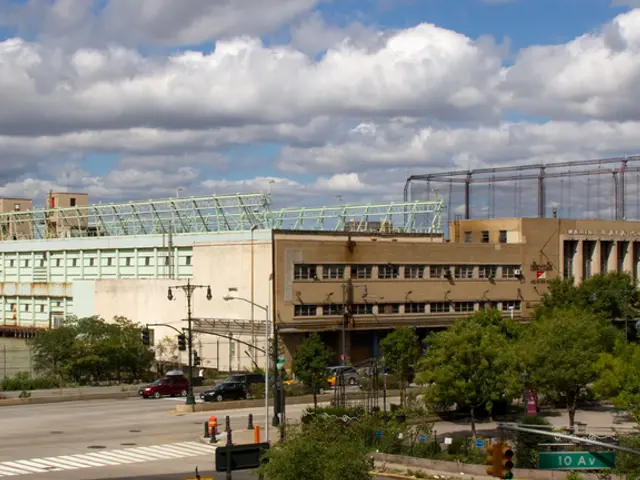Toyota Moves Towards Becoming a Mobility Enterprise: President Sato Discusses Toyota's Future Developments
Toyota Unveils Ambitious Plan for Carbon Neutrality and Mobility Innovations
In a press conference on April 7, President Koji Sato announced Toyota's new management structure and ambitious plans for the future. The company aims to transform into a mobility company, focusing on producing happiness for all while reducing its carbon footprint.
Sato emphasized Toyota's commitment to achieving carbon neutrality across the entire lifecycle of its vehicles by 2050. This includes addressing emissions from design, production, use, recycling, and suppliers and logistics partners.
To achieve this goal, Toyota will adopt a multi-technology approach, incorporating hybrid electric vehicles (HEVs), plug-in hybrids (PHEVs), battery electric vehicles (BEVs), and fuel cell electric vehicles (FCEVs). The company plans to expand their global electrified vehicle lineup to at least 70 models by 2025, including the battery electric bZ4X and advancing hydrogen fuel cell technology exemplified by the Toyota Mirai.
Toyota is also committed to reducing direct operational greenhouse gas emissions (Scope 1 and 2) by 68% by 2035 relative to 2019 levels, and targeting a 30% reduction in Scope 3 emissions from suppliers, logistics, dealerships, and a 35% cut in emissions from vehicle use by 2030. The company will invest in renewable energy such as solar, wind, hydrogen, and renewable natural gas to power factories and manufacturing processes.
Regarding expanding the value of mobility, Toyota is focused on creating sustainable and inclusive mobility that leverages diverse technologies and new business models. The company sees mobility not just as transportation, but as an enabler of a sustainable society through innovation that covers the entire life cycle of vehicles and extends into hydrogen infrastructure and smart electric mobility solutions.
Toyota will strengthen sales of hybrid electric vehicles, increase plug-in hybrid electric vehicle options, and expand the lineup of battery electric vehicles (BEVs). The company aims to reduce average CO2 emissions for vehicles sold worldwide by 33% by 2030 and more than 50% by 2035 compared to 2019.
In addition, Toyota will work on developing next-generation BEVs, creating new business models, and accelerating projects for the realization of the hydrogen society. The company will collaborate with partners across industries and countries to expand the realm of using hydrogen and develop carbon-neutral fuels.
President Sato reiterated Toyota's mission to make "ever-better cars" and expressed his desire to continue sharing the joy of car-making with colleagues. Under the new management structure, Toyota aims to transform into a mobility company, promoting the practical popularization of electrified vehicles to steadily reduce CO2 emissions. The new management style of "simultaneously and organically working as a team" will help Toyota achieve its vision of a sustainable and inclusive mobility future, with cars becoming more connected to society, providing seamless mobility experiences that are connected with other mobilities.
The future cars will offer new value for cars as part of the social infrastructure, linked to various services that support people's daily lives. Toyota values car-making as a team effort with 370,000 associates worldwide and will gather movements of energy and information and link them together as one through data.
In conclusion, Toyota’s plan combines a broad portfolio of clean technologies, supply chain cooperation, renewable energy use, and sustainable mobility innovations to reach carbon neutrality by 2050 and to deliver greater value through accessible, eco-friendly mobility worldwide.
[1] Toyota Global Website. (2021). Toyota's Environmental Challenge 2050. Retrieved from https://global.toyota/en/sustainability/challenge/2050/ [3] Toyota Global Website. (2021). Toyota's Environmental Challenge 2050. Retrieved from https://global.toyota/en/sustainability/challenge/2050/ [5] Toyota North America. (2021). Toyota's Environmental Challenge 2050. Retrieved from https://www.toyota.com/usa/ourcommitment/environment/challenge-2050/
- In their bid for carbon neutrality, Toyota plans to invest in renewable energy from various sources like solar, wind, hydrogen, and renewable natural gas, showcasing its commitment to technology advancements in the energy sector.
- Toyota's ambitious plans for the future involve expanding their global electrified vehicle lineup, including hybrid electric vehicles (HEVs), plug-in hybrids (PHEVs), battery electric vehicles (BEVs), and fuel cell electric vehicles (FCEVs), signifying their expansion into the automotive and technology sectors.




